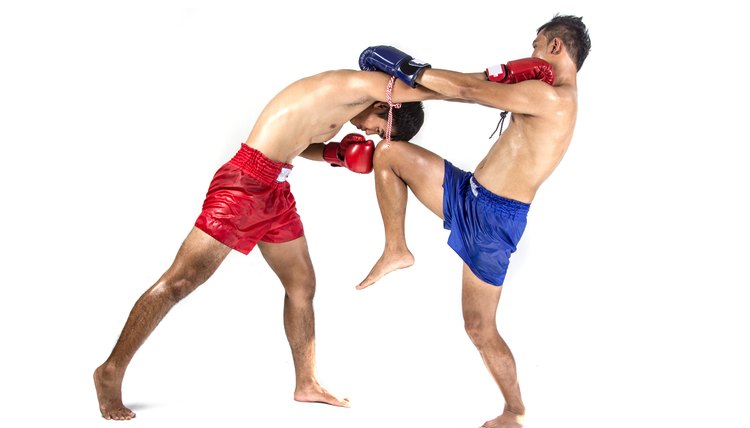Kickboxing & Knee Problems

Muay Thai and other styles of kickboxing, whether for cardio exercise or martial arts competition, provide rigorous exercise for practitioners. However, you must be careful in your training to avoid injuries, especially to your knees. Excessive wear and tear on the knees can be painful -- even requiring surgery in the most serious cases -- and potentially curtail your kickboxing training.
Identification
The website of the International Fitness Association, or IFA, identified a series of causes of knee injuries sustained by kickboxers. These causes include inadequate warm-ups and stretches, hyperextension of the knees and ducking moves that can overextend or torque the knees. Further, executing a side kick without rotating the hip puts lateral pressure on the knee, the IFA states.
Types
Chiropractor and martial artist Dr. John H. Park described two of the most common types of knee injuries that occur among kickboxers and other martial artists in a 2008 article in "Fight" magazine. Most injuries to knee ligaments, the tissues that connect bones, result from overeager beginners or from mistakes in competitive fighting. Common knee injuries for kickboxers include sprains to the anterior cruciate ligament, ACL, and the medial collateral ligament, MCL. The ACL prevents hyperextension of the knee. Hyperextending the knee while pivoting and resisting a leg strike can sometimes result in an ACL injury. The MCL, located on the inside of the knee, joins the leg and thigh. A hit to the outside of the knee often can injure the MCL. You can also incur an acute patellar injury which is caused by a blow to the knee or a fall.
Features
A kickboxer with an ACL or MCL injury will generally feel a popping sensation, followed immediately by pain, according to Park. Other symptoms of an ACL injury include swelling of the knee joint and difficulty walking. If you injure your MCL, you will feel pain on the inside of the knee, as well as swelling and a feeling of instability in the knee.
Effects
ACL sprains have three grade of severity. A grade I sprain is painful but involves only minimal injury to the ligament. A grade II sprain involves more injury, as well as some looseness in the knee joint. A grade III sprain is the most severe, involving complete tearing of the ligament. An MRI is necessary to determine the severity of an ACL sprain.
Prevention/Solution
If you completely tear your ACL, you will need surgery to continue kickboxing training and competition. The operation reconstructs the ligament with ligaments or tendons from another part of your leg or from a cadaver. After the surgery, you will need physical therapy, which Park says can make your injured knee good as new. To avoid knee injuries during training, the IFA advises kickboxers to keep their knees soft and slightly bent during training and competition, and to avoid overextending the knees when executing kicks. Taping the knee if you have a mild strain, will also help you avoid further damage.
Explore In Depth
References
- Better Health: Martial Arts - Preventing Injury
- Evans J, Nielson J l. Anterior cruciate ligament (ACL) knee injuries. In: StatPearls. Treasure Island (FL): StatPearls Publishing; 2019.
- Knee ligament sprains and tears: Clinical practice guidelines—ensuring best care. J Orthop Sports Phys Ther. 2017;47(11):824. doi:10.2519/jospt.2017.0511
- Makhmalbaf H, Shahpari O. Medial collateral ligament injury; A new classification based on MRI and clinical findings. A guide for patient selection and early surgical intervention. Arch Bone Jt Surg. 2018;6(1):3-7.
- Bronstein RD, Schaffer JC. Physical Examination of the Knee: Meniscus, Cartilage, and Patellofemoral Conditions. J Am Acad Orthop Surg. 2017;25(5):365-374. doi:10.5435/JAAOS-D-15-00464
- Browne K, Kurtz CA. How to perform a comprehensive examination of the knee. JAAPA. 2009;22(6):20-25. doi:10.1097/01720610-200906000-00005
Writer Bio
Shane Hall is a writer and research analyst with more than 20 years of experience. His work has appeared in "Brookings Papers on Education Policy," "Population and Development" and various Texas newspapers. Hall has a Doctor of Philosophy in political economy and is a former college instructor of economics and political science.
